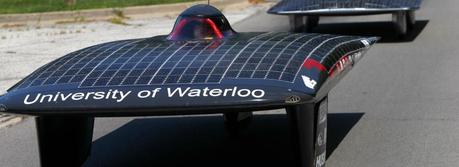 The University of Waterloo's Midnight Sun VII ready to depart the first checkpoint of the American Solar Challenge 2003 at Lincoln Land Community College in Springfield, Ill. Read more about this car below. (Credit: Midnight Sun Solar Rayce Car Team)
The University of Waterloo's Midnight Sun VII ready to depart the first checkpoint of the American Solar Challenge 2003 at Lincoln Land Community College in Springfield, Ill. Read more about this car below. (Credit: Midnight Sun Solar Rayce Car Team)In this review we are looking at five solar cars that are remarkable in one way or the other. While most solar cars have been built specifically for the purpose of solar car races and their design is is severely limited by the amount of energy input into the car, there are some signs that solar PV energy can already be directly used for at least some commercial applications in the automotive industry.
Silver Arrow
Mercedes is not the best-known solar car manufacturer today, but in fact it was Mercedes-Benz’s Silver Arrow that won the Tour de Sol in 1985 (Switzerland)—the first ever rally for solar powered vehicles. The Tour de Sol was carried out annually from 1985 to 1993. The first event started on June 25 in Romanshorn on the Lake of Constance, and finished on June 30 in Geneva. 72 vehicles started in two classes; over 50 finished.
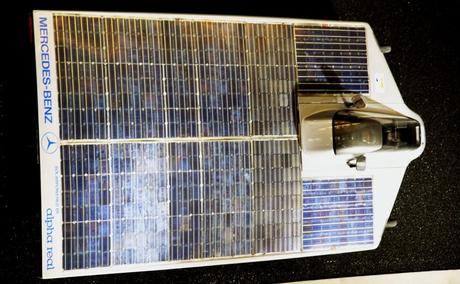
Mercedes-Benz Silver Arrow/Alpha-Real solar car in Mercedes-Benz museum, Stuttgart (Germany)
The Midnight Sun VII
This is the car that made the Guinness World Record for the “Longest Journey by Solar Electric Vehicle.” The Midnight Sun VII solar car team from the University of Waterloo in Ontario, Canada, traveled a distance of 15,070 km (9,364 miles) through Canada and the United States, departing from Waterloo on 7 August and finishing in Parliament Hill, Ottawa, Canada, on 15 September 2004.
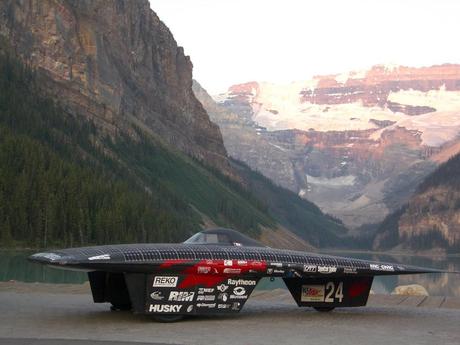
The world record breaker Midnight Sun VII. (Credit: Midnight Sun Solar Rayce Car Team)
Sunswift IV
The record for the fastest solar-powered car was 88.738 km/hr (approx. 55.14 mph) and was achieved by Sunswift IV, built by the University of New South Wales Solar Racing Team and driven by Barton Mawer (Australia) at the naval base HMAS Albatross near Nowra, in NSW, Australia, on 7 January 2011. This broke the previous record held by the General Motors car Sunraycer of 78.3 kilometers per hour (48.7 mph). The Sunswift IV car powered by 400 silicon cells is the project of a group of students from the Faculty of Engineering at the University of New South Wales in Sydney. The car weighed around 200 kilograms (440.93 lbs) with its batteries removed, so the vehicle was powered only by its solar panels.
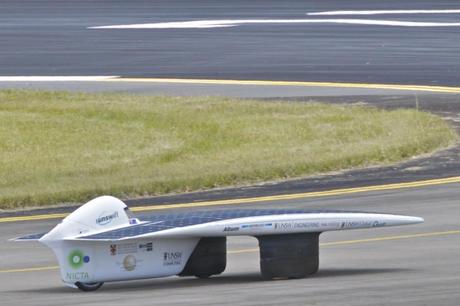
Sunswift IVy during the World Solar-Car Speed Record attempt. (Credit: Bradhall71 http://en.wikipedia.org/wiki/File:Sunswift_IVy.jpg)
Toyota Prius Hybrid
The 2013 Toyota Prius Hybrid is not by any definition a solar car. However, we decided to include it to this review because of its new feature: the “solar roof”. Solar panels that are fitted on the roof of the car can power a fan to circulate ambient air through the cabin when Prius is parked in direct sunlight. This feature helps keep cabin air temperature close to that of the outside air for a more comfortable return to the vehicle. While this is very far from a real solar-powered car, it is interesting to see that solar energy is being used as a power source in a mass produced car.
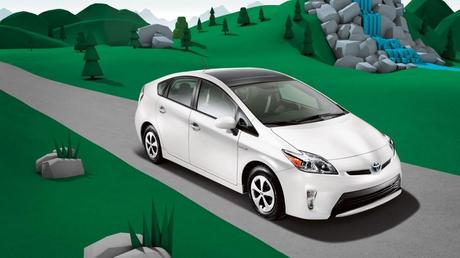
The available Solar Roof is embedded with solar panels that can power a fan to circulate ambient air through the cabin when Prius is parked in direct sunlight. (Credit: Toyota)
Stella
The Solar Team Eindhoven (STE) at the Eindhoven University of Technology (TU/e), Netherlands, presented the world’s first solar-powered family car. “Stella” is the first “energy-positive car” with enough room for four people, a trunk, intuitive steering and a range of 600 kilometers (approx. 370 miles). Its solar cells generate more electricity on average than the car uses and that means that the surplus electricity can be returned to the power grid, thereby making the car “energy-positive.” STE is going to certify the car officially for road use to prove that this is a fully-functional model valid for practical use.
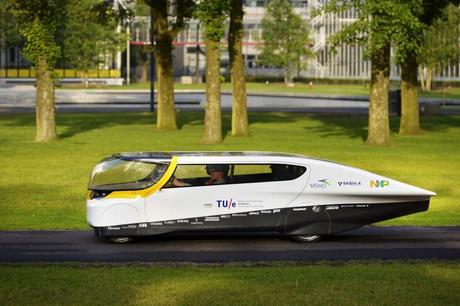
Stella, world’s first solar-powered family car. (Photo: Bart van Overbeeke)

